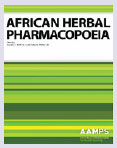Serviços Personalizados
Artigo
Indicadores
Links relacionados
-
 Citado por Google
Citado por Google -
 Similares em Google
Similares em Google
Compartilhar
South African Journal of Science
versão On-line ISSN 1996-7489
versão impressa ISSN 0038-2353
S. Afr. j. sci. vol.107 no.9-10 Pretoria Out. 2011
BOOK REVIEW
African medicinal flora in the limelight
Nokwanda P. Makunga
Department of Botany and Zoology, Stellenbosch University, Stellenbosch, South Africa
Book Title: African herbal pharmacopoeia
Book Cover:

Editors: Thomas Brendler; Jacobus N. Eloff; Ameenah Gurib-Fakim; L. Denzil Phillips
ISBN: 978-99903-89-09-8
Publisher: Graphic Press Ltd, Mauritius; 2010, R886.00*
Review Title: African medicinal flora in the limelight
In the past few years, African medicinal plants have received considerable attention, and it has been lamented that the documentation of the continent's species that are used in traditional medicine lags behind China and India in terms of 'internationally recognised phytochemical standards'. This book not only redresses this issue, but is the first to include plants from the south, north, east and west of Africa. In South Africa alone, there are over 3000 species that are used for medicinal purposes, with over 70% of the Black African population relying on medicinal flora as part of their primary health care and 84% of clinic patients confirming their preference for wild-crafted raw herbal medicines in spite of having access to western health care.1 Both traditional and Western healing systems are used - many educated Black people retain traditional practices as they are regarded as an important cultural link to their predecessors. Throughout Africa, plants are viewed as contributors to health; they are also used in religious and cultural ceremonies. The African continent has a rich biodiversity and this is matched by a commensurate proliferation of medicinal plant use. So the trade of medicinal plants in Africa is substantial, but largely informal, and consists of plant collectors as well as traders at herbal markets.
This book has been assembled by medicinal plant researchers from various African countries who function under the umbrella of the African Association of Medicinal Standards. These researchers identified the need for the documentation of African herbal products, and emphasise the urgency of the standardisation of African natural botanical products for healing. A format similar to that used in other continents has been used to provide a herbal monograph for the plants that are discussed. Each plant monograph includes a general description that focuses on scientific names, botanical aspects and distribution of the plant species, which is followed by descriptions of ethnobotanical uses, known chemical secondary compounds which function as the main bioactive ingredients, and quality control measures. The efficacy of medicinal plants depends on the chemical constituents that they accumulate through secondary metabolism - often it is the mixture of metabolites that renders them effective. Plants respond to both biotic and abiotic factors and environmental impacts on secondary metabolism may cause alterations to the chemicals produced. These alterations affect the quality and safety of herbal medicinal products. Post-harvest processing of material may also influence the effectiveness of medicinal plants, in which case standardisation for commercialisation becomes an important factor in production. Several phytochemical profiling methods are used to analyse the chemical constituents of plants, including both simple (thick layer chromatography) and sophisticated chromatographic (liquid chromatography and gas chromatography) methods, as well as near-infrared spectroscopy. The book is a useful resource, as it outlines pharmacological and clinical studies that have been conducted, as well as safety information on the various ethnomedicinal products.
Several southern African plants feature prominently in the book, including Hoodia gordonii, Hypoxis hemerocallidea (African potato), Pelargonium sidoides (Umckaloabo or African geranium), Prunus africana (red stinkwood) and Sutherlandia frutescens (cancer bush). Many of the plants discussed in the book are of regional significance to local communities in Africa and have not yet found a place in the global natural products sector. However, a few are becoming increasingly important. For example, Pelargonium sidoides is used to manufacture several products that are commercially significant, traded as Linctagon (South Africa), Umckaloabo® (Europe), Kaloba® (United Kingdom) or Umckan® (Brazil).
Overall, the book details methods and procedures that may be employed in studying the efficacy and chemistry of medicinal flora. Many natural product chemists have indicated the need to conduct extensive phytochemical evaluation of medicinal plants so as to better understand the chemical constituents of African flora. This work should thus find a place in the bookshelves of both those generally interested in African medicinal plants, as well as those that are interested in the phytochemistry and pharmacology of plants in general.
Reference
1. Mander M, Ntuli L, Diedericks N, Mavundla K. South Africa's traditional medicines industry. Pretoria: Department of Trade and Industry; 2007. [ Links ]
 Postal address:
Postal address:
Private Bag X1
Matieland 7602, South Africa
Email: makunga@sun.ac.za
© 2011. The Authors. Licensee: OpenJournals Publishing. This work is licensed under the Creative Commons Attribution License.
* Book price at time of review














